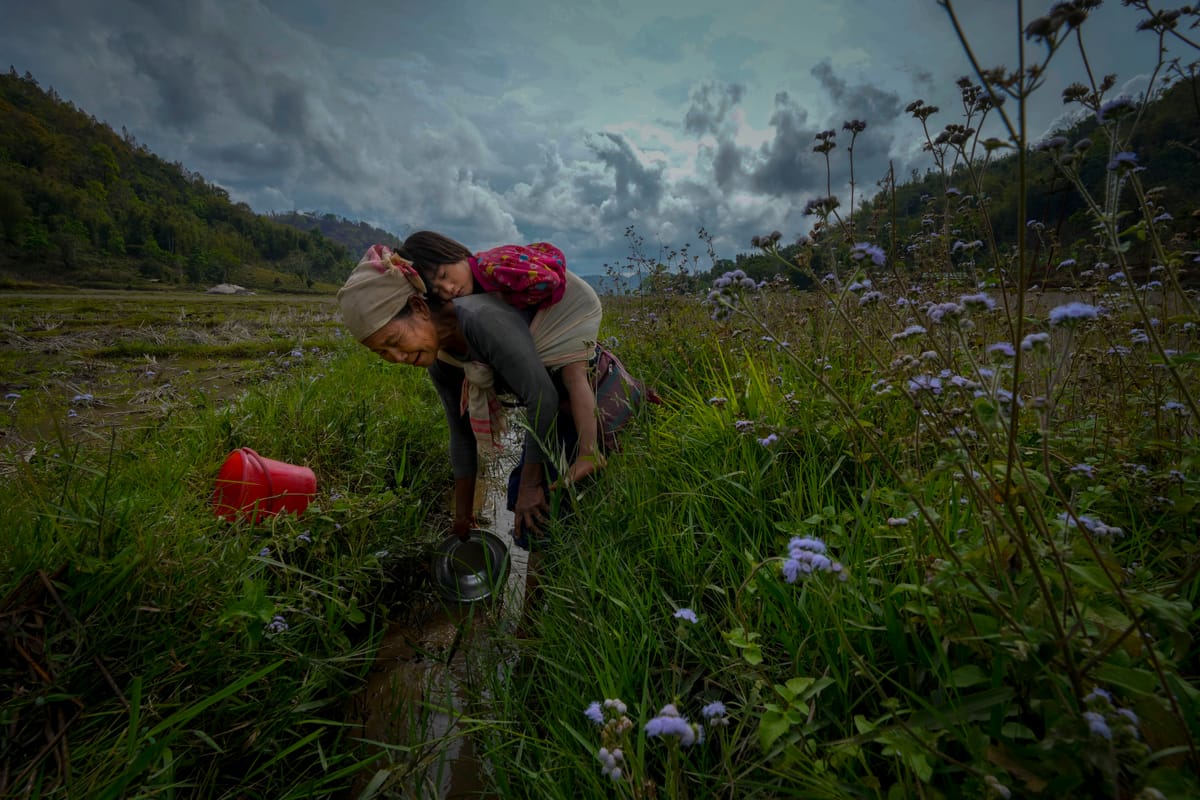Punishing heat that hovered and hung on much longer than usual. Flash floods that washed away large swaths of land and life. And wildfires that burned much of the year, leaving a wake of smoke and charred earth.
The toll of disasters propelled by climate change in 2023 can be tallied with numbers — thousands of people dead, millions of others who lost jobs, homes and hope, and tens of billions of dollars sheared off economies.
But numbers can’t reflect the way climate change is experienced — the intensity, the insecurity and the inequality that people on Earth are living. Associated Press photographers around the world captured moments in 2023 that collectively tell that story, one of a changing world.
INTENSITY
In so many skies, there was smoke, seen in the distance and breathed up close. From Canada to Greece to Hawaii, wildfires raged, consuming land while the flames fanned a thick haze that traveled around the globe. So intense were the wildfires in Canada that they released several times more air pollution than the entire country usually does in a year, working against world efforts to reduce greenhouse emissions, which fuel climate change.
There was also intense heat and desperate efforts to find relief — during a year on track to be the warmest in recorded history. In China, two little girls held small fans in front of their faces, while in Romania a father and daughter delighted in the mist of a public fountain. In Switzerland, a man walked toward the Rhone Glacier, which is melting like so many other glaciers worldwide.
And there was rain, that caused destruction. After Storm Daniel unleashed a torrent from the sky, floods in Libya killed more than 11,000 people, with several thousand others missing. In India, a woman wailed after a landslide washed away houses, leaving family members trapped under rubble. In the U.S., two people waded through water in a laundry mat after major flooding.
Local residents watch a wildfire in Avantas village, near Alexandroupolis, Greece, Aug. 21.
—Achilleas Chiras
A woman carries her pet dogs as residents are evacuated on rubber boats through floodwaters in Zhuozhou, south of Beijing, Aug. 2.
—Andy Wong
A residential swimming pool hangs on a cliffside after a landslide in San Clemente, Calif., March 16.
—Jae C. Hong
A man talks on his phone as he looks through smoke from wildfires in Canada at the George Washington Bridge in Fort Lee, N.J., June 7.
—Seth Wenig
Children cool themselves with electric fans as they take a rest near the Forbidden City on a hot day in Beijing, June 25.
—Andy Wong
A woman, whose family members are trapped under rubble, wails after a landslide washed away houses in Raigad district, India, July 20.
—Rafiq Maqbool
Wildfire destruction is visible in Lahaina, Hawaii, Aug. 10.
—Rick Bowmer
A person runs to avoid the flames of a wildfire in Gennadi village, on the island of Rhodes, southeastern Greece, July 25.
—Petros Giannakouris
A girl touches her father’s head as they are engulfed by mist from a public fountain on a hot day in Bucharest, Romania, July 13.
—Andreea Alexandru
Rescuers recover the body of a person killed during flooding in Derna, Libya, Sept. 15.
—Ricardo Garcia Vilanova
A skier moves along a lit pathway during the polar night in Longyearbyen, Norway, Jan. 6.
—Daniel Cole
The McDougall Creek wildfire burns on the mountainside above houses in West Kelowna, British Columbia, Aug. 18.
—Darryl Dyck, The Canadian Press
A boat travels through a section of the Amazon River affected by drought near Manacapuru, Brazil, Sept. 27.
—Edmar Barros
Pamela and Patrick Cerruti empty coins from Pajaro Coin Laundry as floodwaters surround machines in the community of Pajaro in Monterey County, Calif., March 14.
—Noah Berger
A cameraman walks up to the Rhone Glacier near Goms, Switzerland, June 16.
—Matthias Schrader
A train passes a railroad crossing between flooded fields in Nidderau-Eichen, Germany, Jan. 16.
—Michael Probst
Birds fly over debris in the aftermath of Hurricane Otis in Acapulco, Mexico, Oct. 28.
—Felix Marquez
INSECURITY
In so many places, floods, powerful storms and heat waves wiped out supplies of food. That led to hunger, forced people to migrate in search of sustenance and increased pressure on governments to respond.
In India, a woman cooked in her flooded home while her husband prayed, a scene of both devastation and resilience. In neighboring Pakistan, people waited in the rain to receive food distributed by volunteers outside a camp for internally displaced migrants — as Cyclone Biparjoy ominously approached. In Zimbabwe, a woman worked a field of millet, a cereal that is more resistant than other crops to changes in temperature.
In Argentina, men fished amid many floating carcasses of fish killed by drought and multiple heat waves that jacked up river temperatures and dried out landscapes across areas of South America. A hemisphere away, seemingly endless heat imperiled sheep herding, central to the culture of Navajo in the U.S. Farther west, in Alaska, men worked fishing boats with the knowledge that this year’s catch could be much less than last year’s, as climate change is upending their livelihood.
A tribal woman tries to catch fish as her granddaughter dozes off on her back in a paddy field on the outskirts of Guwahati, India, March 20.
—Anupam Nath
Fisherwomen and men pull in a net of fish off the coast of Chuao, Venezuela, June 7.
—Matias Delacroix
Jestina Nyamukunguvengu walks near a pearl millet crop in Zimbabwe’s arid Rushinga district, Jan. 19.
—Tsvangirayi Mukwazhi
A woman sits next to baskets filled with fish as she works at a market on the shore of the Senegal River in Saint Louis, Senegal, Jan. 20.
—Leo Correa
Yaad Ali, left, offers prayers as his wife Monuwara Begum cooks food in their flooded house in the Brahmaputra River in Sandahkhaiti, Assam, India, Aug. 29.
—Anupam Nath
People wait in the rain to receive free food distributed from volunteers outside a camp for people displaced from coastal areas in Sujawal, Pakistan, June 15, as Cyclone Biparjoy was approaching.
—Pervez Masih
Workers harvest cranberries at Golden Eagle Farms, in Pitt Meadows, British Columbia, Oct. 12.
—Darryl Dyck, The Canadian Press
Jay Begay holds the caul fat from a sheep, Sept. 6, in the community of Rocky Ridge, Ariz., on the Navajo Nation.
—John Locher
Men fish amid dead fish floating near the shore of the Salado River during a drought in Buenos Aires province, Argentina, Jan. 22.
—Natacha Pisarenko
Jorge Martinez works the fires at his taco stand at sunset on a hot day in Mexicali, Mexico, July 19.
—Gregory Bull
A farmer walks back from saffron fields after a day of work in Pampore, Indian-controlled Kashmir, Nov. 5.
—Mukhtar Khan
Oumar Abdoulaye Sow sits at a water trough after giving water to his cows in the village of Fete Forrou, Senegal, April 11.
—Leo Correa
A worker hops over an irrigation canal as he applies fertilizer to a sugar cane field in Albion, Guyana, April 15.
—Matias Delacroix
Darren Platt, left, captain of the Agnes Sabine, and first-year deckhand Juan Zuniga, right, step over nets as they dock the boat for refueling in Kodiak, Alaska, June 23.
—Joshua A. Bickel
Goats and sheep run toward a water point before undertaking a journey to a new location in the Munkh-Khaan region, Mongolia, May 14.
—Manish Swarup
INEQUALITY
In every place that climate change made its mark, inequality was made worse.
Desperation could be seen in the eyes of Pakistani children, standing in the mud and looking through a window while it rained at a camp set up for internally displaced people. It gripped people in Kenya who must go deeper and deeper to access groundwater, as periodic drought has plagued East Africa.
On the other side of the African continent, in a coastal community in Senegal, desperation was felt by women who say they have had to turn to prostitution, thanks to depleted fish populations from climate change and fallout from an offshore gas drilling project.
In Malawi, coffins with people killed during heavy rains from Cyclone Freddy lay in the mud while family and friends, standing under a large tent, said goodbye.
In India, where floods frequently forced evacuations, a displaced farmworker, squatting over dirt, washed her face. In Sri Lanka, a man stood in debris from his home, destroyed by erosion. On this day, the seas were calm, but as the planet continues to warm, more storms are ahead.
Yaad Ali, left, and his son Musikur Alam row a boat to collect drinking water in the floodwaters in Sandahkhaiti, a floating island village in the Brahmaputra River, Assam, India, Aug. 30.
—Anupam Nath
People take items from a store in the aftermath of Hurricane Otis, in Acapulco, Mexico, Oct. 28.
—Felix Marquez
Jay Begay, left, and his mother, Helen, butcher a sheep at their home Sept. 6, in the community of Rocky Ridge, Ariz., on the Navajo Nation.
—John Locher
Children are seen through a car window outside a camp set up for people displaced by Cyclone Biparjoy’s approach in Badin, Pakistan, June 15.
—Fareed Khan
An Indigenous Wari’ boy swims in the Komi Memem River, at Wari’ community in Guajara-Mirim, Brazil, July 13.
—Andre Penner
Joyce Ngui, left, fetches water in Athi River, Kenya, Oct. 17.
—Brian Inganga
A boy walks on plastic waste at the Badhwar Park beach on the Arabian Sea coast in Mumbai, India, June 5.
—Rajanish Kakade
A woman poses for a photo in Saint Louis, Senegal, Jan. 21. She said she had to resort to prostitution last year after her fisherman husband left the city and cut contact.
—Leo Correa
Rekha Devi, a farm worker, washes her face next to her temporary shelter in New Delhi after her family fled the flooded banks of the Yamuna River, Aug. 9.
—Altaf Qadri
People attend a burial ceremony for some of the people who died following heavy rains caused by Cyclone Freddy in Blantyre, Malawi, March 15.
—Thoko Chikondi
Neelam Tamar, suffering from heatstroke, recovers at the Lalitpur district hospital, in India, June 17.
—Rajesh Kumar Singh
Dilrukshan Kumara looks at the ocean as he stands by the remains of his family’s home destroyed by erosion in Iranawila, Sri Lanka, June 15.
—Eranga Jayawardena
A woman carries a water jug as she walks back to her home in New Delhi, March 22.
—Altaf Qadri
Credits
Text: Peter Prengaman
Associated Press climate and environmental coverage receives support from several private foundations. See more about AP’s climate initiative here. The AP is solely responsible for all content.

